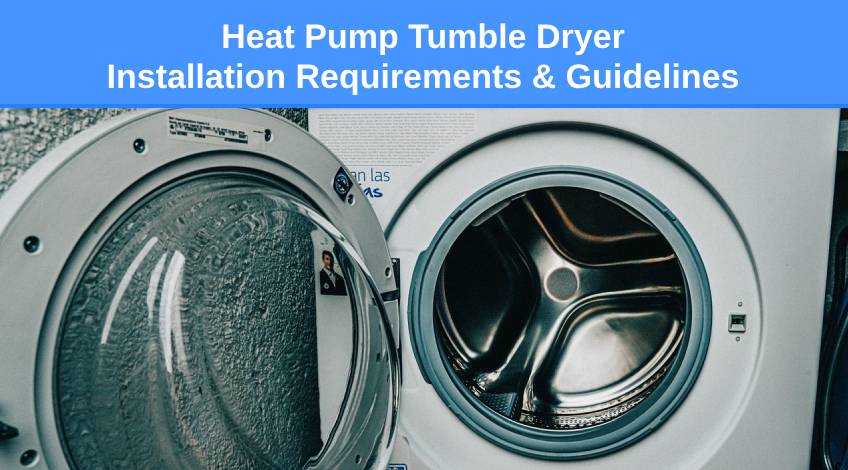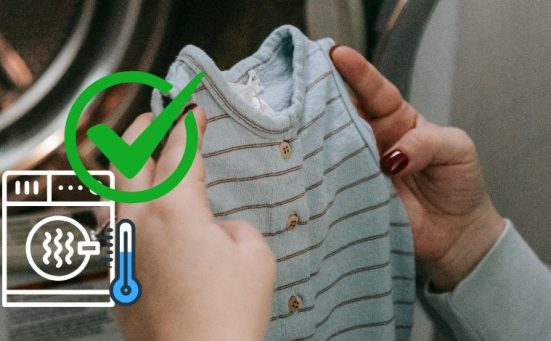
Heat Pump Tumble Dryer Installation Requirements & Guidelines
If you’ve just upgraded to a heat pump tumble dryer you will probably have heard that they can be installed anywhere. And while it’s true that heat pump dryers don’t need to be vented (so they don’t need to be placed near an outside wall or window), there are limitations.
You’ve made quite a large investment by buying a heat pump dryer so you’re going to want to install it correctly. Not only so that it gives you years of service, but also because your warranty could be invalidated if it’s installed incorrectly.
To find out exactly where and how to install a heat pump tumble dryer keep reading.
Do Heat Pump Tumble Dryers Need A Vent?
Heat pump dryers remove moisture using a condenser and collect the water in an on-board water tank. This means that they don’t need a vent to clear the hot, wet air.
If you’re replacing a vented dryer with a heat pump model, you can block the hole in the wall that was needed for the vent hose. Which means your home should be slightly warmer.
Do Heat Pump Dryers Need To Be Connected To The Water Supply Or Drainage System?
All that pump dryers need is a power supply to operate. The water extracted from the laundry is stored in a water tank in the appliance which will need to be manually emptied regularly but there’s no need for any plumbing at all.
However, there is an optional drain hose that can be installed but it’s not obligatory (see below).
Can Heat Pump Dryers Be Stacked?

To save space, it is possible to stack a heat pump dryer on top of a washing machine. As long as you use a manufacturer approved stacking kit (consult your user manual for more information).
Ensure that the dryer is stacked correctly and get help when lifting the appliance into position.There will be fitting instructions provided with the stacking kit to give you guidance on the correct installation procedure.
Can Heat Pump Tumble Dryers Be Wall Mounted?
Unlike vented dryers which are relatively light, heat pump dryers cannot be wall mounted.This is due to the weight of heat pump dryers, which are far heavier especially when the water tank is full. This means the brackets would not be able to support the weight of the dryer.
Can Heat Pump Dryers Be Installed Upside Down?
Some people prefer to have their tumble dryers installed upside down to make it easier to access the control panel. This is not possible with heat pump dryers because they cannot be wall mounted.
Heat pump dryers have a water tank at the top of the appliance that needs emptying ideally after every use. Installing a heat pump dryer upside down would cause it to leak as the water tank can only be fitted one way.
Even if you decide to use the optional drain hose (see below) you could still not install the appliance upside down. This is because the control panel cannot be fitted any other way than the way it comes supplied. Which means the digital display would be upside down.
What Is The Best Place To Install A Heat Pump Tumble Dryer?

Many experts will tell you that the difference between heat pump dryers and vented dryers is heat pump models can be installed anywhere within reason. The important part of that last sentence is the “within reason” bit.
So what does “within reason” mean in relation to the installation of heat pump dryers? Let’s take a look at the best place to install a heat pump dryer. Heat pump tumble dryers need to be installed;
In A Room With A Temperature Between 5° to 35°C

As heat pump dryers (and condenser dryers) work using a condenser to remove moisture they are particularly sensitive to cold environments.
If the temperature of the room the dryer is in drops to below 5°C the condensation will happen too early in the cycle which will only get the laundry slightly dry, or in some cases not get dry at all.
With that said, if the temperature in the room is too hot, above 35°C the air will be too hot for the condenser to condense the air into water. This can cause serious issues with your dryer.
This means that although it is feasible to install a heat pump dryer in a garage or outbuilding, the practicalities might make it difficult. There’s no way to really regulate the temperature of many outbuildings. They can be too hot in summer and way too cold in winter.
With Adequate Ventilation
For the heat pump dryer to work correctly, it needs adequate ventilation. This means the area at the front of the appliance where the air inlet is should be free from any obstructions and the sides and back need at least 3 to 5 cm clearance.
It is recommended that the area around the dryer needs to be at least 3m2 to provide enough fresh air to prevent overheating.
This means that if you want to, it’s OK to install a heat pump dryer under a worktop as long as you have the minimum requirements for ventilation.
You can also install a heat pump dryer in a cupboard as long as the area is large enough to allow adequate ventilation.
It’s also best if the room has a window that can be opened to increase the air flow. If not you should install the heat pump dryer in a large room and leave the door open to help improve the air flow.
One final point concerning ventilation, never under any circumstances place your dryer anywhere near curtains.
On Level Ground
If your heat pump dryer is not installed on level ground, it’s likely to create too much vibration which could lead to it breaking down. If the ground sloped too much there’s a possibility of the dryer leaking.
You should use a spirit level to ensure the dryer is level before use. You can adjust the screw feet on the bottom corners of the appliance.
On A Hard Surface
Not only does the floor need to be level, it also needs to be a hard floor. Any hard surface like a wooden floor, concrete floor or a stone floor is fine.
What’s not fine is a carpeted floor because carpets can cause a fire hazard. Remember heat pump dryers can reach operating temperatures of 50°C which could be hot enough to pose a fire risk.
Plus any loose fibres from the carpet could get taken into the air inlet whilst a thick pile carpet could prevent adequate air flow beneath the dryer. The reason heat pump dryers have raised feet is to allow air to flow beneath the appliance to prevent overheating.
Close To A Sink
Although heat pump dryers, like condenser dryers, don’t need to be plumbed in, it’s a good idea to install them close to a sink or drain. This is because you will need to empty the water tank on a regular basis.
Having the appliance close to a sink or drain will prevent you from lugging a tank full of water the length of your home. Remember 1 litre of water weighs 1kg which means the water tank will be quite heavy.
Added to which, there’s far less chance of you spilling any water if you’re not carrying it too far.
Drainage Hose
Many heat pump dryers come supplied with an optional drain hose that can be fitted and used in place of the water tank. If you decide on installing the drain hose it will mean you no longer need to worry about emptying the water tank as the waste water will drain away through the drain hose and down the drainpipe.
This means the dryer will need to be installed near enough to a sink or drain so that the drain hose reaches. This is a relatively easy task but if you’re not sure of your plumbing skills, we recommend getting a plumber or tumble dryer technician to do it for you.
Close To A Wall Socket
As with all large appliances, it’s not recommended that heat pump dryers are plugged into an extension cable. Pretty much every heat pump tumble dryer manufacturer stipulates that using an extension cable with their appliance will invalidate the warranty.
This means that you will need to install your heat pump dryer close enough to a standard 240 volt wall socket that’s fully earthed. If you don’t have a socket close enough to the place you want to install your dryer, you will need to get a new socket installed.

Before First Use
Above we’ve dealt with all of the main requirements for the installation of a heat pump tumble dryer. Now let’s look at some safety instructions to help you get the best from your new heat pump dryer.
Allow The Appliance Time To Settle
Once your new heat pump dryer has been installed, many manufacturers recommend allowing the appliance to stand for a few hours to settle.
This is to give the refrigerant in the condenser time to settle in much the same way as you do for a fridge or freezer. You’ll need to consult your user manual as the settling time varies depending on the make and model you have purchased.
Some suggest as little as 2 to 3 hours while others state a 24 hour settling in period.
Read The User Manual
We know you probably have a thousand and one things to do, but it really is important that you read the user manual before using your new appliance. Let’s face it, you’ll have at least 2 hours before you can use your new dryer, so you should be able to find enough time to read the little booklet that came with it.
Getting to know how your new appliance works is invaluable as it can save you a lot of time in the future. You will find out exactly how much laundry you can dry at any given time (this will vary depending on the size of the drum on your appliance).
You will also learn where the filter(s) are, how to clean them and how often they will need to be emptied. As well as how all of the various controls and programmes work.
Most also include a troubleshooting guide in case something goes wrong along with comprehensive cleaning instructions.
SEE ALSO: Heat Pump Vs Condenser Tumble Dryer
Frequently Asked Questions
Heat pump dryers don’t need special installation, and can be installed anywhere within reason. However, they do need adequate ventilation to prevent overheating and subsequent damage.
Heat pump tumble dryers can be installed anywhere that has adequate ventilation.
You don’t need a plumber to install a heat pump tumble dryer as they have an on-board water tank to collect the water extracted from the laundry. However, you can have the optional drain hose plumbed in which is best done by a plumber.
You can put a heat pump tumble dryer in a cupboard as long as you allow adequate ventilation. You will need a 3 to 5 cm gap around the back and sides of the appliance and you must have the air inlet free from any obstructions. This might mean leaving the cupboard door open when the appliance is working.
You should never put a heat pump tumble dryer on carpet because it is a fire hazard. The appliance needs a free air flow underneath to prevent overheating. Plus any loose fibres can get sucked into the air inlet which could cause a fire.
Heat pump tumble dryers cannot be wall mounted because they are too heavy for the brackets. The only tumble dryers that can be wall mounted are vented dryers.
Also, follow us on Pinterest ...



